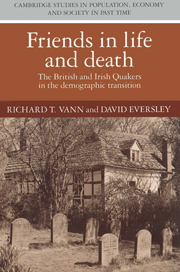Book contents
- Frontmatter
- Contents
- List of figures
- List of tables
- Preface
- Introduction
- 1 The quality of the sources
- 2 Characteristics of the sample
- 3 Marriage according to Truth
- 4 The fruitfulness of the faithful
- 5 The quality and quantity of life
- Conclusion
- Bibliography
- Index
- Cambridge Studies in Population, Economy and Society in Past Time
4 - The fruitfulness of the faithful
Published online by Cambridge University Press: 23 September 2009
- Frontmatter
- Contents
- List of figures
- List of tables
- Preface
- Introduction
- 1 The quality of the sources
- 2 Characteristics of the sample
- 3 Marriage according to Truth
- 4 The fruitfulness of the faithful
- 5 The quality and quantity of life
- Conclusion
- Bibliography
- Index
- Cambridge Studies in Population, Economy and Society in Past Time
Summary
Just as Quaker marriages were distinctive, so were their patterns of child-bearing after marriage. In fact, investigation of their fertility produced some of our most surprising findings; but before we give these, we should briefly explain how we measured fertility.
As is usual among demographers, we focus on women and count, in various ways, the number of children which married women bore. With the Quakers, the emphasis on married women is justified by the fact that marital fertility was virtually the total fertility. Although there is no record of any illegitimate births in Friends’ registers, since mothers of bastards would have been promptly disowned, there is no reason to believe that illegitimate births amount to more than a minute fraction of the total births to Quaker women.
Fertility, to Anglo-Saxon demographers, is measured in the number of live births. It would obviously be desirable to know more about fecundity, or the capacity to conceive; but this would require knowledge of how often conceptions occurred as well as the frequency of live births, and while the latter can be counted, there is no way to tell how many pregnancies ended in miscarriages. Even stillbirths are not included in our figures, which express fertility only in terms of live births.
Live births can be measured in a number of different ways, each of which illuminates a different aspect of Quaker reproductive behavior. The three basic measures are: family size, age-specific fertility rates, and intergenesic intervals. All require some preliminary explanation.
- Type
- Chapter
- Information
- Friends in Life and DeathBritish and Irish Quakers in the Demographic Transition, pp. 129 - 185Publisher: Cambridge University PressPrint publication year: 1992

